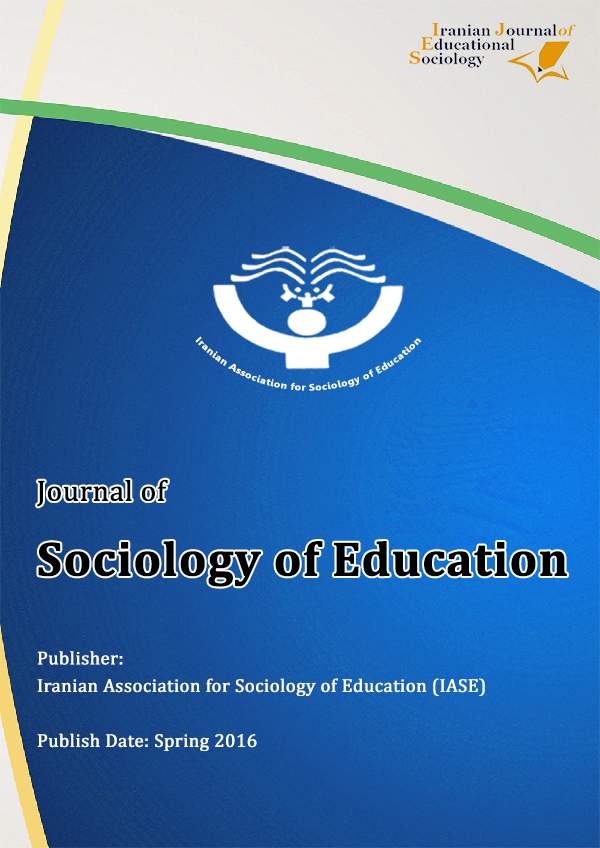Presenting a Structural Model of Nomophobia Based on Emotional Self-Awareness Mediated by Psychological Distress in Students
Keywords:
Nomophobia, Emotional Self-Awareness, Psychological Distress, Structural Equation Modeling, StudentsAbstract
Purpose: This study aimed to explain a structural model of nomophobia based on emotional self-awareness mediated by psychological distress among university students.
Methodology: A descriptive–correlational design using structural equation modeling (SEM) was employed. The statistical population included students of the Faculty of Islamic Education (Department of Psychology and Counseling) at Islamic Azad University, Karaj Branch, during the second semester of the 2023–2024 academic year. A total of 250 students were selected through convenience sampling. Data collection instruments included the Nomophobia Questionnaire (Yildirim & Correia, 2015), the Emotional Self-Awareness Scale (Grant et al., 2002), and the Kessler Psychological Distress Scale (Kessler et al., 2002). Data analysis was conducted using SPSS22 and AMOS, and model fit indices were examined.
Findings: Emotional self-awareness significantly predicted psychological distress (β = -0.37, p ≤ 0.001) and nomophobia (β = -0.54, p ≤ 0.001). Psychological distress had a positive direct effect on nomophobia (β = 0.65, p ≤ 0.001). The indirect effect of emotional self-awareness on nomophobia through psychological distress was significant (β = -0.24, p ≤ 0.001). Fit indices including χ²/df = 2.25, RMSEA = 0.071, GFI = 0.99, CFI = 0.97 confirmed good model fit.
Conclusion: The findings indicate that emotional self-awareness reduces nomophobia both directly and indirectly by decreasing psychological distress. Enhancing emotional skills may therefore help reduce nomophobia among university students.
Downloads
References
Abdoli, N., Bahmani, D., Salari, N., Khodamoradi, M., Farnia, V., Jahangiri, S., & Brand, S. (2023). Nomophobia (No Mobile Phone Phobia) and Psychological Health Issues Among Young Adult Students. European Journal of Investigation in Health Psychology and Education, 13(9), 1762-1775. https://doi.org/10.3390/ejihpe13090128
Aldhahir, A., Bintalib, H., Siraj, R., Alqahtani, J., Alqarni, O., Alqarni, A., & Alwafi, H. (2023). Prevalence of Nomophobia and Its Impact on Academic Performance Among Respiratory Therapy Students in Saudi Arabia. Psychology research and behavior management, 16, 877-884. https://doi.org/10.2147/PRBM.S404898
Alizadeh, M., Miyan Bandi, G., Ashouri, A., & Hosseini, M. (2020). Investigating the Relationship Between Nomophobia and Sleep Quality in Students. 6th International Conference on Psychology, Educational Sciences, and Lifestyle,
Argumosa‐Villar, L., Boada‐Grau, J., & Vigil‐Colet, A. (2017). Exploratory Investigation of Theoretical Predictors of Nomophobia Using the Mobile Phone Involvement Questionnaire (MPIQ). Journal of adolescence, 56, 127-135. https://doi.org/10.1016/j.adolescence.2017.02.003
Ayala, M. J., Alegre de la Rosa, O. M., Chambi Catacora, M. A. D. P., Vargas Onofre, E., Cari Checa, E., & Díaz Flores, D. (2025). Nomophobia, phubbing, and deficient sleep patterns in college students. Frontiers in Education, 9, 1421162. https://doi.org/10.3389/feduc.2024.1421162
Cerniglia, L., Cimino, S., Marzilli, E., Pascale, E., & Tambelli, R. (2020). Associations Among Internet Addiction, Genetic Polymorphisms, Family Functioning, and Psychopathological Risk: Cross-sectional Exploratory Study. Jmir Mental Health, 7(12), e17341. https://doi.org/10.2196/17341
Choi, N. G., Sullivan, J. E., DiNitto, D. M., & Kunik, M. E. (2019). Associations Between Psychological Distress and Health-Related Behaviors Among Adults With Chronic Kidney Disease. Preventive Medicine, 126, 105749. https://doi.org/10.1016/j.ypmed.2019.06.007
Chowdhury, N., Kevorkian, S., Hawn, S. E., Amstadter, A. B., Dick, D., Kendler, K. S., & Berenz, E. C. (2018). Associations Between Personality and Distress Tolerance Among Trauma-Exposed Young Adults. Personality and individual differences, 120, 166-170. https://doi.org/10.1016/j.paid.2017.08.041
Davari, A., & Rezazadeh, A. (2018). Structural Equation Modeling with PLS Software. https://elmnet.ir/doc/31443680-21402
Derbich, J., Kuk, A., & Milde, K. (2024). The Smartphone That Cannot Be Abandoned - The Phenomenon of Nomophobia Among Students. Kwartalnik Naukowy Fides et Ratio, 58(2), 27-37. https://doi.org/10.34766/fetr.v58i2.1272
Elhai, J., Hall, B., Levine, J., & Dvorak, R. (2018). Types of Smartphone Usage and Relations With Problematic Smartphone Behaviors: The Role of Content Consumption vs. Social Smartphone Use. Cyberpsychology Journal of Psychosocial Research on Cyberspace, 11(2). https://cyberpsychology.eu/article/view/7069
Gohar, A., & Munir, M. (2022). Attachment Styles and Nomophobia in Young Adults: The Mediating Role of Mindful Awareness. Pakistan Journal of Psychological Research, 37(4), 637-652. https://doi.org/10.33824/PJPR.2022.37.4.38
Gómez-Salgado, J., Andrés-Villas, M., Domínguez-Salas, S., Díaz-Milanés, D., & Ruiz-Frutos, C. (2020). Related Health Factors of Psychological Distress During the COVID-19 Pandemic in Spain. International journal of environmental research and public health, 17(11), 3947. https://doi.org/10.3390/ijerph17113947
Gyasi, R. M. (2019). Social Support, Physical Activity and Psychological Distress Among Community-Dwelling Older Ghanaians. Archives of Gerontology and Geriatrics, 81, 142-148. https://doi.org/10.1016/j.archger.2018.11.016
Hamzaa, H., Atta, M., Omar, M., Machaly, E., Amin, S., & Wahba, N. (2024). Examining Nursing Students' Prevalence of Nomophobia, and Psychological Alienation and Their Correlates with Fear of Missing Out: A Multisites Survey. Sage Open Nursing, 23779608241301223. https://doi.org/10.1177/23779608241301223
Hussien, R. (2022). The Association Between Nomophobia and Loneliness Among the General Population in the Kingdom of Saudi Arabia. Middle East Current Psychiatry, 29(1). https://mecp.springeropen.com/articles/10.1186/s43045-022-00235-8
Kafi Nia, F., & Farhadi, H. (2020). The Effectiveness of Group Cognitive Behavioral Therapy on Emotional Self-Awareness and Problem-Solving Skills of Students Addicted to the Internet. Journal of Psychological Sciences, 19(85), 111-120. https://psychologicalscience.ir/article-1-344-en.html
Kessler, R. C., Andrews, G., Colpe, L. J., Hiripi, E., Mroczek, D. K., Normand, S. L., & Zaslavsky, A. M. (2002). Short Screening Scales to Monitor Population Prevalences and Trends in Nonspecific Psychological Distress. Psychological medicine, 32(6), 959-976. https://doi.org/10.1017/S0033291702006074
Khan, S., Atta, M., Malik, N. I., & Makhdoom, I. F. (2021). Prevalence and Relationship of Smartphone Addiction, Nomophobia, and Social Anxiety Among College and University Late Adolescents. İlköğretim Online, 20(5). https://ilkogretim-online.org/index.php/pub/issue/view/56
Kukreti, S., Ahorsu, D., Strong, C., Chen, I., Lin, C., Ko, N., & Pakpour, A. (2021). Post-Traumatic Stress Disorder in Chinese Teachers During COVID-19 Pandemic: Roles of Fear of COVID-19, Nomophobia, and Psychological Distress. Healthcare, 9(10), 1288. https://doi.org/10.3390/healthcare9101288
León-Mejía, A. C., Gutiérrez-Ortega, M., Serrano-Pintado, I., & González-Cabrera, J. (2021). A Systematic Review on Nomophobia Prevalence: Surfacing Results and Standard Guidelines for Future Research. PLoS One, 16(5), e0250509. https://doi.org/10.1371/journal.pone.0250509
Lian, S., Sun, X., Niu, G., Yang, X., Zhou, Z., & Yang, C. (2021). Mobile Phone Addiction and Psychological Distress Among Chinese Adolescents: The Mediating Role of Rumination and Moderating Role of the Capacity to Be Alone. Journal of affective disorders, 279, 701-710. https://doi.org/10.1016/j.jad.2020.10.005
Mahna, S., & Talab Pasand, S. (2016). The Relationship Between Environmental Support and Emotional Self-Awareness with Academic Engagement: The Mediating Role of Academic Well-being. Iranian Journal of Medical Education, 16, 31-42. https://ijme.mui.ac.ir/browse.php?a_id=3795&sid=1&slc_lang=fa
Mechraoui, O., Jelleli, H., Feikh-Romdhane, F., Rebhi, M., Saidane, M., Guelmami, N., & Dergaa, I. (2023). The Relationship Between Nomophobia and Psychological Distress in Tunisian Students: The Moderating Effect of Physical Activity. TJSSM, 8-19. https://doi.org/10.61838/kman.tjssm.1.1.3
Mozafari, M., & Ghayrati, S. (2023). Predicting Nomophobia Based on the Role of Self-Esteem and Feelings of Loneliness in Youth. 1st International Conference on Psychology, Social Sciences, Educational Sciences, and Philosophy,
Notara, V., Vagka, E., Gnardellis, C., & Lagiou, A. (2021). The Emerging Phenomenon of Nomophobia in Young Adults: A Systematic Review Study. Addiction & Health, 13(2), 120. https://pubmed.ncbi.nlm.nih.gov/34703533/
Notara, V., Vagka, E., Lagiou, A., & Gnardellis, C. (2023). Perceived Health and Nomophobia Among Young Adults: The Mediating Role of Depression and Stress. Sustainability, 16(1), 96. https://doi.org/10.3390/su16010096
Panova, T., & Carbonell, X. (2018). Is Smartphone Addiction Really an Addiction? Journal of Behavioral Addictions, 7(2), 252-259. https://doi.org/10.1556/2006.7.2018.49
Rahme, C., Hallit, R., Akel, M., Chalhoub, C., Hachem, M., Hallit, S., & Obeïd, S. (2021). Nomophobia and Temperaments in Lebanon: Results of a National Study. Perspectives in psychiatric care, 58(4), 1607-1612. https://doi.org/10.1111/ppc.12968
Sheikh, B., Hariri, N., Alqahtani, M., Aljabri, A., Eterji, A., Almutawa, S., & Alhejaili, A. (2024). Prevalence and associated factors of nomophobia amongst the general population in Makkah province and Al-Madinah province, Saudi Arabia: an analytical cross-sectional study. Clinical Practice and Epidemiology in Mental Health, 20(1). https://doi.org/10.2174/0117450179311620240508105100
Teasdale, T. W., & Antal, K. (2016). Psychological Distress and Intelligence in Young Men. Personality and individual differences, 99, 336-339. https://doi.org/10.1016/j.paid.2016.05.016
Tuco, K., Castro-Díaz, S., Soriano-Moreno, D., & Benites‐Zapata, V. (2023). Prevalence of Nomophobia in University Students: A Systematic Review and Meta-Analysis. Healthcare informatics research, 29(1), 40-53. https://doi.org/10.4258/hir.2023.29.1.40
Uguz, G., & Bacaksız, F. (2021). Relationships Between Personality Traits and Nomophobia: Research on Nurses Working in Public Hospitals. Perspectives in psychiatric care, 58(2), 673-681. https://doi.org/10.1111/ppc.12834
Walsh, S. P., White, K. M., & Young, R. M. (2010). Needing to Connect: The Effect of Self and Others on Young People's Involvement with Their Mobile Phones. Australian Journal of Psychology, 62(4), 194-203. https://doi.org/10.1080/00049530903567229
Yildirim, C., & Correia, A. P. (2015). Exploring the Dimensions of Nomophobia: Development and Validation of a Self-Reported Questionnaire. Computers in human Behavior, 49, 130-137. https://doi.org/10.1016/j.chb.2015.02.059
Downloads
Published
Submitted
Revised
Accepted
Issue
Section
License
Copyright (c) 2025 Moeen Ghanizadeh Khajeh Pasha (Author); Mohsen Mansoubifar; Mohammad Reza Belyad, Masoumeh Zhian Bagheri, Javid Peymani (Author)

This work is licensed under a Creative Commons Attribution-NonCommercial 4.0 International License.










